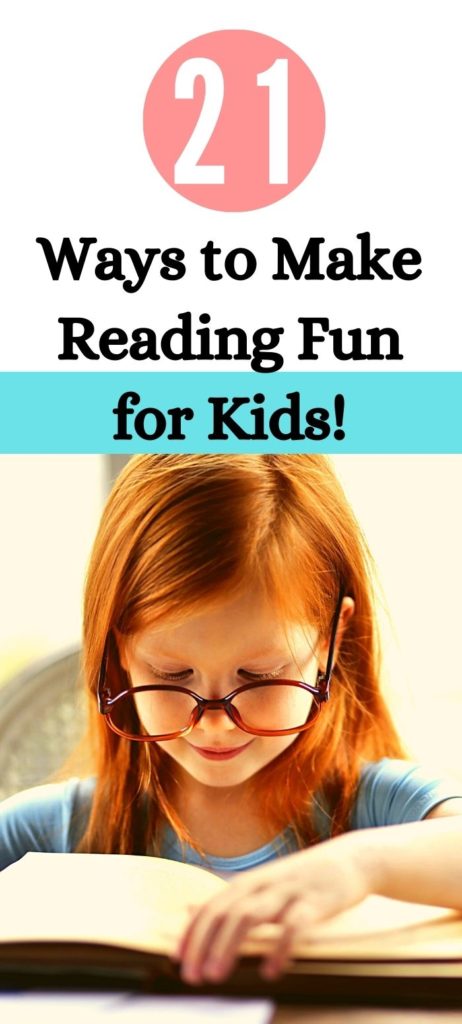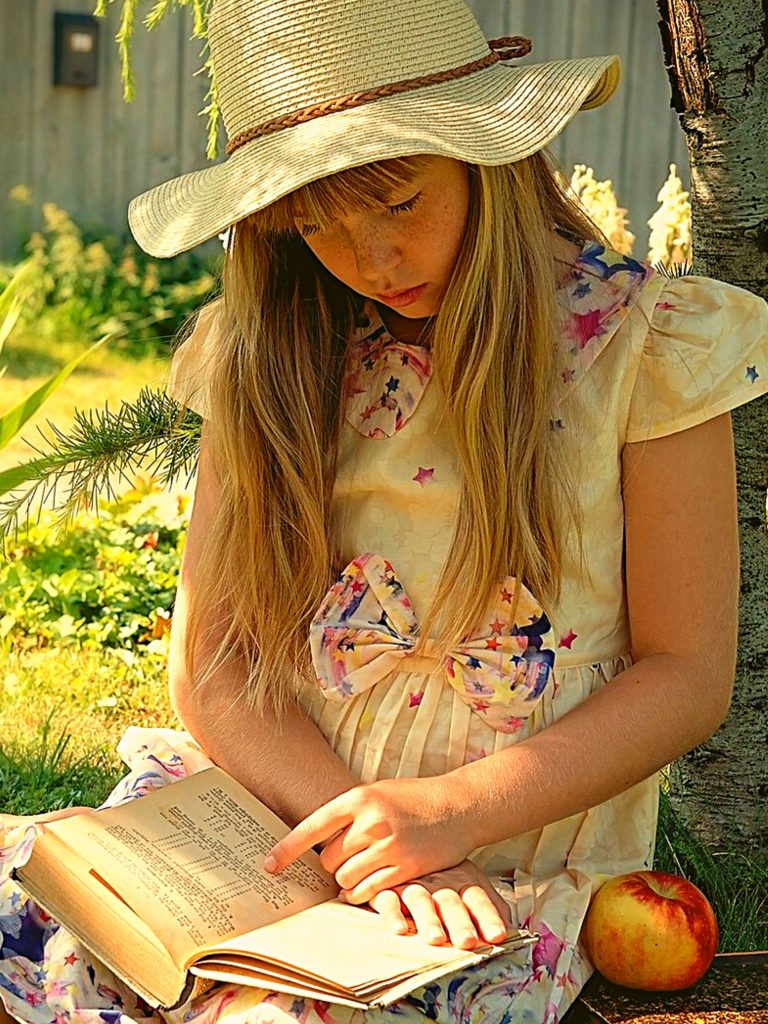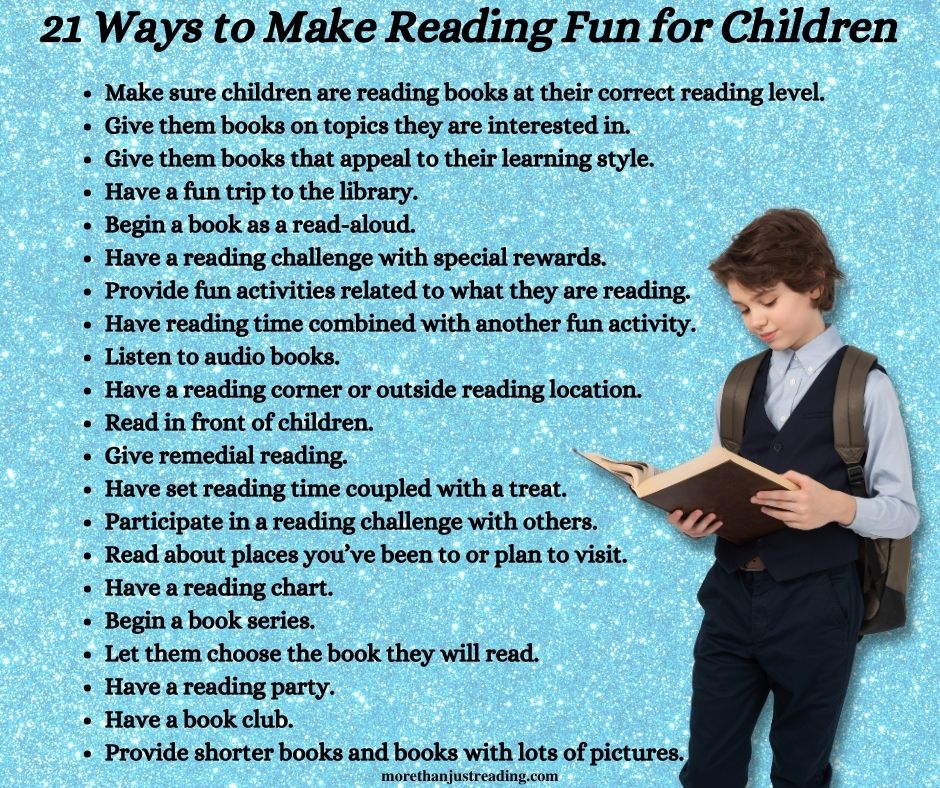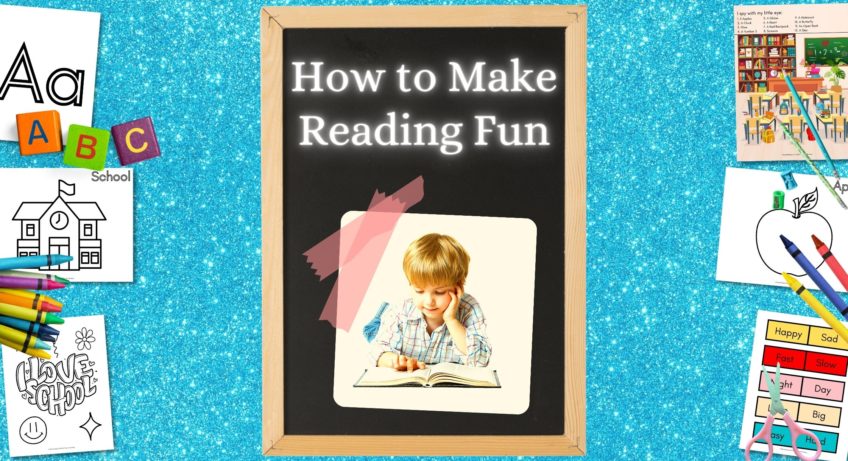“Mom, I’m bored,” a young girl complains.
“Well, why don’t you go find something to do with one of your siblings,” her mother suggests.
“They’re all reading.”
“Then why don’t you find a book to read? The bookshelves are full to bursting with books. Surely you could find something there to interest you.”
The girl eyes the overfull bookshelves. They are filled with all different varieties of books, fat ones, skinny ones, tall ones, short ones, colorful ones, and plain ones. And the genres are just as diverse as the physical appearance of the books. So shouldn’t she be able to find something there to interest her? There is just one problem.
Sadly, the girl turns back to her mother. “But Mom, I don’t like reading.”
“Well, I think it’s time we remedy that. Books are a valuable resource, and if you learn to love reading, that will be a lifelong blessing. Let’s see what we can do to help you develop that love.”
21 Ways to Make Reading Fun
In this post I will be sharing 21 different ways to make reading fun for children. They may not all work for your child since each child is different, but there will surely be some ideas that they will enjoy.

Making Reading Fun
- Make sure children are reading books at their correct reading level.
- Give them books on topics they are interested in.
- Give them books that appeal to their learning style.
- Have a fun trip to the library.
- Begin a book as a read-aloud.
- Have a reading challenge with special rewards.
- Provide fun activities related to what they are reading.
- Have reading time combined with another fun activity.
- Listen to audio books.
- Have a reading corner or outside reading location.
- Read in front of children.
- Give remedial reading.
- Have set reading time coupled with a treat.
- Participate in a reading challenge with others.
- Read about places you’ve been to or plan to visit.
- Have a reading chart.
- Begin a book series.
- Let them choose the book they will read.
- Have a reading party.
- Have a book club.
- Provide shorter books and books with lots of pictures.
Make sure children are reading books at their correct reading level.
If a child is reading books too difficult for them, they may become discouraged and dislike learning. On the flip side, books that are too easy for them might be considered boring and not provide enough of a challenge. Books that have a good challenge, but not too much of a challenge, will be more likely to interest the child who doesn’t enjoy reading.
Give them books on topics they are interested in.
Different children have different interests. Some enjoy learning about airplanes, while others enjoy studying sea animals. Some children prefer reading stories about faraway places while others enjoy stories about dogs. Find out what your child enjoys learning about and provide them with books on those topics. As they read about the topics they enjoy, more likely than not, they will learn to enjoy reading at the same time.
Give them books that appeal to their learning style.
Reading primarily appeals to visual learners, but it can be made interesting for the other learning styles as well. A how-to book would appeal to the hand-on learners while an audio-book (discussed more below) would appeal to the auditory learner.
Have a fun trip to the library.
I always enjoyed going to the library; it was a special treat for us. If your child doesn’t enjoy reading, they might not enjoy going to the library very much. But you can change that. Make going to the library a fun experience. You could combine it with another activity they enjoy: stopping at a favorite park to play for a little while, or getting ice cream or a favorite kind of candy.
Then at the library, you could let your child have the opportunity to help decide what books they want to get, as long as it is something that meets your book criteria. If they get to choose books that look interesting to them, they will be more likely to enjoy reading them.
Begin a book as a read-aloud.
What better way to help your child learn to love reading than to start an exciting book as a read-aloud and then stop part way through, telling them if they want to find out how it ends, they have to finish it. You could start by leaving one chapter unread, and gradually work backwards, so that they are reading more and more of the books to themselves.

Have a reading challenge with special rewards.
Children love contests and challenges, especially if they involve working towards some sort of prize or reward. Set a certain number of books or a certain amount of time for them to read, and have a special reward for them when they complete the challenge. The reward could be a day free of chores, a trip to the park, or some equally tempting activity.
Provide fun activities related to what they are reading.
If your child enjoys working with their hands and doing craft projects, incorporating these into reading time would help them to develop a love for reading. The activities would relate to what they read and reinforce the book. These are the kinds of activities found in my book-based lessons.
Have reading time combined with another fun activity.
What’s a favorite activity of your child’s? Maybe it’s playing outside. Well then, allow them to read outside before going to play. Maybe they enjoy building with Legos. Read aloud to them while they build, or after having them read a little while, tell them to build something they read about. By combining reading with something they already enjoy, they will learn to associate the two and develop an enjoyment of reading.
Listen to audio books.
Listening to audio-books is another reading activity that can be combined with things your child already enjoys doing. While the child listens, they can color or draw, play something quiet that doesn’t take a lot of concentration, or work on a craft.
Have a reading corner or outside reading location.
Make a special location for reading. You could make a reading corner with a comfy chair, cute decorations, and easy access to interesting and fun books. Or you could make an outside place to read. I enjoyed reading in our hammock when I was little. You could have a hammock, swing, or other fun place to read. Making the environment appealing will help your child look forward to reading time, especially if that is the only time they get to use that space.

Read in front of children.
Show your child that you value reading. Read in front of them and show them that you enjoy it. When they realize that reading is a lifelong activity, rather than just something they have to do while they are in school, they will be more apt to decide that it’s not so bad after all.
Give remedial reading.
Some children don’t enjoy reading because they aren’t good at it. Children who are behind in their reading are not able to enjoy the stories and books written for their particular age group. They have to be content with books that they consider too juvenile. By helping your child to improve through remedial reading and reach the reading level for their age group, you may find that their dislike of reading is gone, once they are able to read books written for them.
Have set reading time coupled with a treat.
Besides combining reading time with fun activities, it can also be combined with fun treats. Now, I don’t recommend this for an everyday occurrence, but once in a while, reading time could be combined with a special treat like ice-cream or cookies. Or if your child is used to having a daily afternoon snack, reading time could be combined with that, as long as the snack isn’t messy and capable of damaging the books being read.
Participate in a reading challenge with others.
Maybe you have friends or fellow teachers with children who also don’t enjoy reading as much as they should. Get together with them and plan a reading challenge for all the children to work towards. Have a fun incentive at the end like a picnic, a trip to the zoo, or an ice cream party. Knowing that their friends are doing the challenge too, and knowing they don’t want to miss the reward will motivate your child to work hard to complete the challenge.
Read about places you’ve been to or plan to visit.
Children enjoy when they can relate something they’ve read to something they’ve experienced for themselves. If you’ve been to a famous historical site, find some interesting books about that place for your child to read. They will enjoy learning more about somewhere they’ve been. And when they come to something they already knew or something they saw, that will excite their interest and get them to continue reading.
Another option is to get books about places you plan to visit with your child. If you have an upcoming vacation planned, let your child read about where they will be going. I think pretty much every child gets excited about a vacation, and reading about where they are going will be interesting to them.
Have a reading chart.
When I was younger I enjoyed having sticker charts for my chores and school activities. Have a reading chart for your child where they can put on a sticker every time they finish a book, spend a certain amount of time reading, or read a certain number of pages. Combining multiple reading strategies for you children, you could combine this with one of the reading challenges, so they have a goal they are working towards.
Begin a book series.
There are lots of interesting book series, and getting your child interested in one is a good way to get them reading. You could read the first book or two aloud and then have your child read the others. Once the child is interested in the characters, they will want to continue following along on their adventures.

Let them choose the book they will read.
Don’t ask your child if they want to read. Instead ask them what book they are going to read. This shows them they are going to read, but still lets them be involved in making decisions about their reading material. Let them choose, as long as their choice is in reason. They will choose books that interest them and help them develop a taste for reading.
Have a reading party.
You and your children could have a reading party where each of you brings a fun book to read and has special snacks. You could also plan some other fun activities after everyone is finished reading. This party could also include friends, friends from book club or the group reading challenge.
Have a book club.
You could involve your child in a book club where the members get together and discuss what they are reading. In this way, you can get new book ideas. And your child might be intrigued at the description of a book another member has been reading. They might be so intrigued that they ask to read it without you prompting them to read.
Provide shorter books and books with lots of pictures.
Some children are intimidated by long books. Begin by first providing them with short books and books with fun pictures. Then you could gradually provide them with longer and longer books, as they learn to enjoy them.
Bonus: Combine various reading strategies for children.
Use as many of these different reading activities as you can. The more variety you give your children in reading, the more fun they can have and the more likely it will be that they will come to love reading.

Conclusion:
Some time later:
The young girl does not come to her mother saying she is bored. Instead, implementing some of the reading strategies for children that she has learned, she goes to the bookshelves overflowing with books of all shapes and sizes and colors and chooses one that looks interesting. She takes it to the reading corner and reads for awhile. When she has finished the book, she puts a sticker on her chart.
She is just one book away from completing the reading challenge. Then she’ll be eligible to join the trip to the aquarium she and the other members of her book club will be going on. And as exciting as that book was, it will be so much fun to tell the others about!
This probably won’t happen overnight with your child, but give it enough time, trying out various reading strategies for children, and you will see a change in your child’s attitude toward reading.
For more content like this, lesson plans, reading assignments, and teaching tips, go ahead and sign up for my e-newsletter.
So, did you find any activities to implement to help your child learn to love reading? If so, which ones? And are there any tips you’ve used with good success that aren’t listed here? Let us know in the comments! I know we’d all love to hear them. And they might be just what another teacher or parent is looking for.



Wow!! This was jam-packed full of so many great ideas!! I like the idea of starting a book aloud and having the child finish it to find out what happens.
Thanks Bethany! Glad you enjoyed the post!
Wow! These are all great ideas!!! Going to send this post to a friend that has some children that have a hard time enjoying reading!
Glad you enjoyed the post, Anna! Thank you so much for passing it on! I hope it’s a blessing!
One of the things I discovered with a beginning reader is to ask if they want to read one sentence, or one paragraph. when they chose, we did it that way, they would read, and I would read, and that way we got through the chapter for the day. Books that have “oh no, what is next” parts, are good places to end, so they look forward to the next time. Also, before you start the next reading time, ask how the last story/chapter ended, and what do they think will happen next. Really helps with comprehension. I like chapter books as soon as you can introduce them, helps with attention and comprehension. And a series is always good. I liked LITTLE BRITCHES, not Christian, but very good values and morals. And LITTLE HOUSE books, even for the little ones who have likely seen the TV series. I love teaching kindergarten-2nd grade, mostly kids are eager to learn as long is we keep it light and enjoyable. Thanks for all the good tips and for the service you are providing Hannah.
These are great tips you shared, Gammy! Thank you!